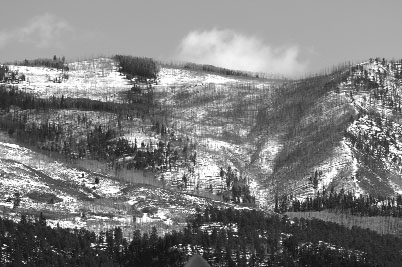
Dead and downed trees littering the burn scar along Missionary Ridge are visible from Highway 160. Officials with the U.S. Forest Service said they are prepared, if conditions are right, to consider managing a fire ignited by lightning and allowing it to clean out some of those fuels./Photo by Jennaye Derge
Fighting fire with fire
Forest Service plans transition to more natural fire management
In the midst of a record drought for the Southwest, dry conditions and available fuels came together like a perfect storm almost 13 years ago. The result was the Valley and Missionary Ridge fires, which burned more than 72,000 acres just north of Durango.
“It’s still fresh in a lot of people’s memories,” said Matt Janowiak, District Ranger with the Columbine Ranger District in the San Juan National Forest.
To suddenly see flames, ash or a column of smoke billowing from that same ridgeline would quickly rekindle the memories of a blaze that boldly knocked on the back door of many.
However, according to the Forest Service, that could be exactly what Mother Nature needs.
“We want to restart the regeneration process,” explained Chris Tipton, fire management officer for the Columbine Ranger District.
Bennett, Gardner introduce funding bill for catastrophic firesThe fighting over party lines ends when it comes to fighting fire. – Tracy Chamberlin |
After devastating wildland fires burned almost 800,000 acres of Yellowstone in 1988, affecting more than one-third of the park, forest managers realized that the policy they’d been operating under for the past century – suppression, suppression, suppression – was not only preventing Mother Nature from taking care of her forests, it was actually setting them up for catastrophic wildland fires.
When fire is put out fast and furious, it prevents the forest from naturally thinning underbrush, invasive species or beetle-killed trees. Eventually, those fuels build up, and when lightning strikes, the result is often an intense, rapidly-burning, catastrophic fire.
These types of fires are not just damaging to property, but far more dangerous for firefighters sent in to battle the blaze. “If we can burn on our terms, it’s not as catastrophic,” Janowiak explained.
The Columbine Ranger District covers 850,000 acres across the Southwest corner of Colorado, and every fire on that acreage is managed, according to Tipton, whose expertise is in wildland and prescribed fire.
Whether it starts by the hand of Mother Nature or Forest Service officials, nothing is ever simply left to burn. Firefighter safety, property, infrastructure and public opinion are all considered.
There is a primary plan for managing fire; an alternative to that plan; a contingency to the alternative; and an emergency plan, too. “We are part of these communities … we want what’s best as well,” Tipton said.
The shift in federal fire policy that followed the Yellowstone incident meant forest mangers needed to allow fire to play its part in the natural ecosystem.
This new policy has been taking root, slowly but surely, all across the nation. Here in the Southwest, it’s taking hold in several ways. One way is by allowing natural ignitions, like lightning strikes, to burn in a managed way.
This is where the column of smoke could billow from Missionary Ridge.
Janowiak and Tipton said people have seen the dead and downed trees littering the burn scar along Missionary Ridge. They know the fuel sits there, waiting for a spark.
If lightning were to strike, Tipton and Janowiak would consider managing the fire and allowing Mother Nature to take care of the forest; and they are prepared to do just that.
Being prepared means having the right conditions, including awareness of the fuels, weather and available resources. The biggest part of that readiness, though, is the community support. “It’s huge,” Janowiak said. “It’s bigger than you can imagine.”
Two other ways of moving toward the natural fire return is by prescribed burns and mechanical fuels reduction, where the thick understory is manually thinned out.
Last year, Tipton and his team worked on a prescribed burn in the Saul’s Creek area just outside of Bayfield. With plenty of community input and preparation, they successfully burned 1,100 acres near the Deer Valley neighborhood, cleaning out the thick understory. Janowiak said they can see it’s having a positive effect on the ecosystem already.
This year, they are looking at some mechanical fuels reduction, perhaps in early to mid-May; and, a prescribed burn in the Fosset Gulch area, which stretches over 14,000 acres south of Highway 160 near Bayfield.
“We’re trying to mimic what a natural fire will do under our conditions … under our terms,” Tipton said.
Whether it’s thinning out a fuel-rich area, igniting a prescribed burn or managing one started by lightning, the goal is a natural fire return, where low-intensity fires are allowed to do their part for the ecosystem and catastrophic fires are few and far between.
It’s not just a long-term goal, but a multi-generational one. “We’re trying to manage for future generations,” Tipton said.
After a century of suppression tactics, it will take time for natural fire to return. Just as changing federal policy takes time. Just as changing the public’s mind takes time.
“There’s no reason we can’t get there,” Janowiak said. “I kind of think we have to get there.”
In this week's issue...
- September 11, 2025
- Back on top
After harrowing flying accident, local highliner steps back out with renewed mission
- September 11, 2025
- New order
Rule change for Land and Water Conservation Fund raises alarms
- September 4, 2025
- Armed with knowledge
Local community organizers work to ensure immigrant neighbors know their rights
